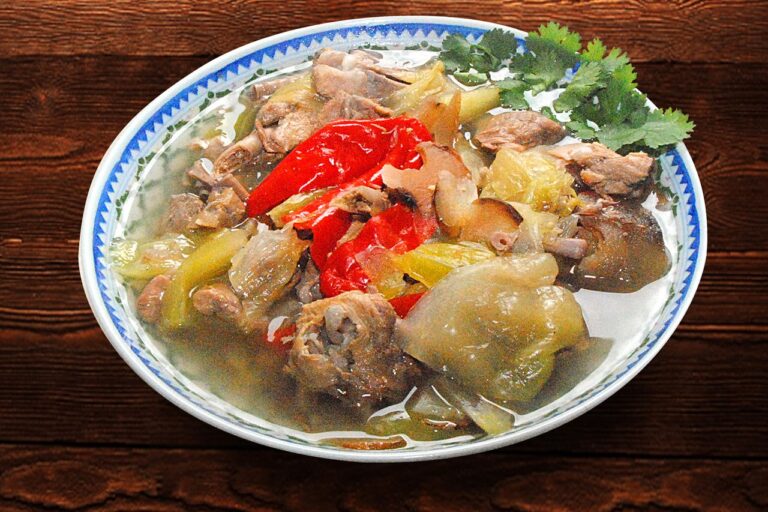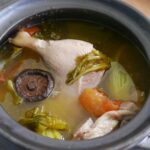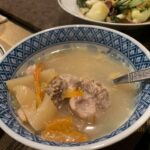Itik Tim: The Delicious Nyonya Duck Soup from Malaysia
Itik Tim (or sometimes Itek Tim/Kiam CHye Ark 咸菜鸭汤) is an iconic Nyonya soup simmered slowly with duck, salted mustard greens, tomatoes, garlic, and asam gelugor. Found especially in Melaka and Penang Nyonya restaurants and households, this soup is a quietly beloved dish, never loud in presentation, but deeply nourishing in spirit.
Itik Tim’s roots are tangled, but lovingly so. Many trace its DNA back to Kiam Chye Ark 咸菜鸭, a salted mustard duck soup popular among Teochew and Hokkien communities, both in China and Malaysia. Migrants from Fujian and Chaoshan brought their versions to Malaya, simmering duck with kiam chye (salted mustard), tomatoes, garlic, ginger, preserved plums, and even rice wine to mask the duck’s gaminess.
The Nyonya’s version is similar. Typical tweaks include asam gelugor or dried tamarind slices for added sourness, lengkuas (galangal) for aromatic depth, and even the occasional splash of brandy to be used like rice wine but with an extra layer of oomph. Optional add-ins like pig trotters, dried belimbing, or buah pala (nutmeg) also reflect the layered, waste-nothing mentality of Nyonya kitchens. Even the blanching stock from the duck gets repurposed, perhaps into Chap Chye (literally Mixed Vegetables 杂菜) the next day.
But there’s another twist in this origin story: a possible Eurasian link. Some sources claim that a Portuguese Eurasian dish called Teem Reunion Soup, supposedly a “Spiced Snow Pear Pork Soup”, was served during Christmas festivities. Over time, this “Teem” was adapted by Melaka’s Peranakan and Eurasian communities into a soup that visually and flavour-wise resembled Kiam Chye Ark. Tomatoes were introduced. Duck replaced pork. But modern Kristang elders in Melaka, generally do not recall any such dish. It might be a culinary ghost, mentioned but fading in living memory.
The name Itik Tim itself reflects this cultural blend. Itik is Malay for duck. Tim (炖), in Hokkien and Teochew, means “to simmer” or “slow-cook”—a nod to the soup’s method. Meanwhile, Teem, from Kristang patois, means “Soup”, though this meaning is controversial and not widely recognized. Despite sounding alike coincidently, Tim and Teem might have entirely different origins, fused together through centuries of trade, colonization, and intermarriage in Malaya.
Preparation-wise, Itik Tim isn’t fussy, but it is careful. The duck is often blanched to remove excess fat (though that collagen-rich liquid is never thrown out). Then it’s slowly simmered with kiam chye, tomatoes, white pepper, garlic, and souring agents like asam gelugor. Some versions add Chinese mushrooms, chili, nutmeg, or even preserved plums. Over hours, the soup becomes soft yet full of characters, sour, slightly salty, with the mellow richness of duck pulling it all together.
Compared to other heavier Nyonya dishes, Itik Tim is one of the few clear soups. Yet it’s not an appetizer. It sits on the table alongside everything else, to be spooned intermittently as you eat.
In Penang, you’ll more likely hear this called Kiam Chye Ark. The name Itik Tim or Itek Tim isn’t commonly used there, reflecting regional language differences. But in Melaka and some Nyonya homes across Malaysia, Itik Tim remains a treasured heirloom recipe. You may still find it served during Chinese New Year, Christmas, or weddings, especially in households that hold on tightly to culinary memory.
Outside the home, Itik Tim rarely appears in kopitiams or hawker stalls. Your best bet is a heritage restaurant with a strong Nyonya menu, or, even better, a dinner invite from a Peranakan auntie who still makes it the old way and maybe a bit of storytelling on the side.





